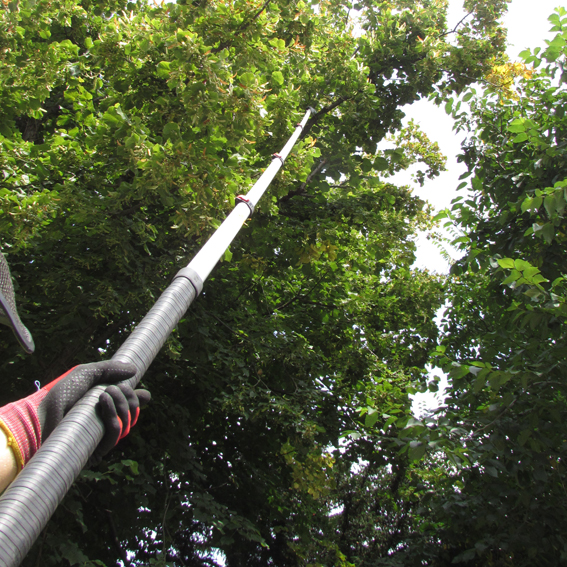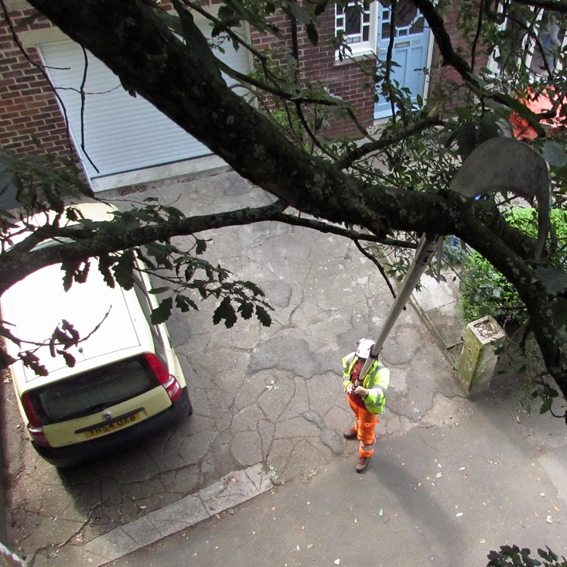
Buyers Guide To Pole Saws
For cutting down and pruning high-level branches, a versatile yet sturdy pole saw is invaluable. They come in many different varieties with different specifications and features. This brief guide will help you to purchase the right pole saw that will do the job you need it to do at an appropriate budget.
The Benefits of using a Pole Saw
Arborists and landscapers need a pole saw to work on high-level branches and foliage. The alternative is to climb the tree and carry out the work with a chainsaw or hand saw, providing you are fully qualified to do so or to access the higher branches using a ladder. However, the guidance from the Health and Safety Executive (HSE) makes it clear that you should carry out a risk assessment and avoid working at height when it is reasonably practicable to do so. A pole saw makes it reasonably practicable. The HSE also advises that as much work as possible should be carried out from the ground.
Investing in a pole saw will not only help you to comply with health and safety legislation but there are many other benefits to having one in your kit.
- Pole saws are relatively non-bulky and lightweight and are therefore not difficult to carry around or store.
- Pole saws make high-level tasks quick to complete, without the need for sending up a climber, which involves set up time, a qualified groundsman, and the time taken to set up redirects and move around the canopy. You need to complete tasks during the working day as efficiently as possible. Pole saws make high-level branch removal a quick, simple job.
- Compared with many of the other tools that you will need to do your job, pole saws are relatively cost-effective and a good model will last for many years if stored properly and looked after.
Types of Pole Saw
There are of course several different types of pole saw. The four main categories of pole saw are:
- Manual pole saws. The simplest but often the most effective type of pole saw. There is no motor; they are simply a blade on an extendable pole. They require some manual effort to use but are relatively safe, simple to use and ideal for most basic pruning tasks.
- Mains powered pole saws. The pole saw is powered by mains electricity through a cable so there is a limit as to where they can be used. They are light, relatively quiet and can exert a lot more power than a manual pole saw and are less tiring to use. The need for a mains power supply does make them impractical though.
- Battery powered pole saws. These are powered by a rechargeable battery so they are relatively quiet and can be used anywhere because they do not need a mains power supply. They cannot be used for long periods of time because the battery will run out, but unlike mains powered pole saws are portable.
- Petrol powered pole saws. The most powerful type of pole saw which can be used anywhere and will run for long periods. The disadvantages are that they are far heavier and noisier than other types of pole saw.

Dos and Don’ts of using a Pole Saw
Although pole saws can in many cases remove the need to work at height, which is far more hazardous, there are nonetheless some risks associated with the improper pole saw use. Below are some to bear in mind.
- Although they are designed to be lifted above the head, you will need to find a weight with which you are comfortable working. Muscle fatigue can set in very quickly when you are lifting your arms above head height for extended periods of time, so this is an important consideration.
- Pole saws should only be used on relatively small branches, typically less than two inches in radius. Wood thicker than this will take too long to cut (causing fatigue) and can create a significant hazard when it falls to the ground.
- Although pole saws are far simpler and safer to operate than chainsaws, using a pole saw properly is still a skilled job. An experienced arborist will know how to reduce the weight of the limb using preliminary and jump cuts before making a final cut.
- Pole saws with extensions longer than eight feet are very heavy and lead to rapid muscle fatigue and cramp, which can be dangerous in a hazardous environment.
- Overhead power lines are a major danger. If it is absolutely necessary to work in the vicinity of power lines, always use a pole saw that has been tested for electrical insulation such as the Zega T3 or Zega T5 fibreglass polesaw set. Never use a pole saw to work on a branch that is above or at the same level as a power line.
- Never stand below the limb that you are working on, as it can easily swing or fall on you.
You need to conduct a proper risk assessment and employ a safe system of working when using pole saws. Start by clearing the area and planning the task. Position yourself correctly before you start cutting.
A Buyer’s Guide to Pole Saws
There are plenty of manual pole saw options out there on the market. Below are some really interesting choices for professional pole saws for arborists, landscapers and other tree workers:
The Bulldog Pruner Set is a good buy for light duty or one-off pruning tasks, particularly for the domestic user. It has a telescopic pole and that can be adjusted to anything between 1.3 metres and 2.4 metres. It includes a rope operated bypass lopper. The blade measures 30cm and can be replaced when needed.
If you need a longer reach, the Zubat Telescopic Pole Saw will reach to 3 metres but will collapse down to 1.5 metres for lower level jobs. The blade is 33 cm long and sports the unbeatable cutting quality of the Silky brand.
If you are looking for a reasonably lightweight tool with ultimate cutting power, the Silky Hayauchi Telescopic pole saw (4.9m) or Silky Hayauchi Telescopic pole saw (6.3m) may suit you. Both have a telescopic aluminium pole which adjusts to a maximum of 4.9m or 6.3m respectively. It is quick to adjust and has an oval section to hold the pole rigid which is needed at the fully extended length. The 39cm long blade has an extremely aggressive cutting capacity, with a sickle (knife edge) at each end of the blade to keep it in the cut. This Silky Hayauchi saw head is generally recognised as the best pole saw blade on the market. Being aluminium, this pole will need taking care of – perhaps not the most robust choice if you’re going to lend it out to heavy-handed teams – but when looked after, is a great tool to use with an easy-to-use extension mechanism and professional quality performance.
For demanding professional user, the Zega T3 poleset or the Zega T5 poleset are an excellent option. Each set comes with 4 x 1.5m fibreglass poles that lock together to give an impressive 6m reach, a saw head, a rope operated lopper (pruner) head and a double action hook. The poles are made from robust fibreglass, are batch tested for use near overhead power lines and have a sturdy push fit locking mechanism to securely hold them together with almost zero play. The T3 set comes with a Bahco blade and Park lopper. The top of the range T5 set comes with the renowned Silky Hayauchi saw head and a very heavy duty Bahco lopper head. Both feature a hook with wire raiser for moving stray hangers or branches out the way. Each tool head comes with its own push fit adapter allowing tool heads to be quickly and easily changed over on the job.
We hope you’ve found our guide helpful! If you have questions or would like to talk to us about the best option for your needs, give our friendly sales team a call on 01780 482231.
